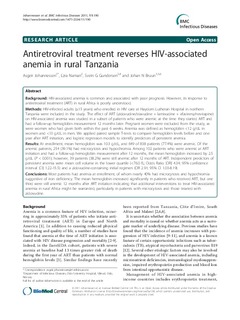| dc.contributor.author | Johannessen, Asgeir | |
| dc.contributor.author | Naman, Ezra | |
| dc.contributor.author | Gundersen, Svein Gunnar | |
| dc.date.accessioned | 2011-11-11T13:10:25Z | |
| dc.date.available | 2011-11-11T13:10:25Z | |
| dc.date.issued | 2011 | |
| dc.identifier.citation | Johannessen, A., Naman, E., Gundersen, S. G., & Bruun, J. (2011). Antiretroviral treatment reverses HIV-associated anemia in rural Tanzania. BMC Infectious Diseases, 11(1), 190. doi: 10.1186/1471-2334-11-190 | no_NO |
| dc.identifier.issn | 1471-2334 | |
| dc.identifier.uri | http://hdl.handle.net/11250/135308 | |
| dc.description | Published version of an article from the journal: BMC Infectious Diseases. Also available from the publisher: hhtp://dx.doi.org/10.1186/1471-2334-11-190 . Open Access | no_NO |
| dc.description.abstract | BACKGROUND:HIV-associated anemia is common and associated with poor prognosis. However, its response to antiretroviral treatment (ART) in rural Africa is poorly understood.METHODS:HIV-infected adults ([greater than or equal to]15 years) who enrolled in HIV care at Haydom Lutheran Hospital in northern Tanzania were included in the study. The effect of ART (zidovudine/stavudine + lamivudine + efavirenz/nevirapine) on HIV-associated anemia was studied in a subset of patients who were anemic at the time they started ART and had a follow-up hemoglobin measurement 12 months later. Pregnant women were excluded from the study, as were women who had given birth within the past 6 weeks. Anemia was defined as hemoglobin <12 g/dL in women and <13 g/dL in men. We applied paired sample T-tests to compare hemoglobin levels before and one year after ART initiation, and logistic regression models to identify predictors of persistent anemia.RESULTS:At enrollment, mean hemoglobin was 10.3 g/dL, and 649 of 838 patients (77.4%) were anemic. Of the anemic patients, 254 (39.1%) had microcytosis and hypochromia. Among 102 patients who were anemic at ART initiation and had a follow-up hemoglobin measurement after 12 months, the mean hemoglobin increased by 2.5 g/dL (P < 0.001); however, 39 patients (38.2%) were still anemic after 12 months of ART. Independent predictors of persistent anemia were mean cell volume in the lower quartile (<76.0 fL; Odds Ratio [OR] 4.34; 95% confidence interval [CI] 1.22-15.5) and a zidovudine-containing initial regimen (OR 2.91; 95% CI 1.03-8.19).CONCLUSIONS:Most patients had anemia at enrollment, of whom nearly 40% had microcytosis and hypochromia suggestive of iron deficiency. The mean hemoglobin increased significantly in patients who received ART, but one third were still anemic 12 months after ART initiation indicating that additional interventions to treat HIV-associated anemia in rural Africa might be warranted, particularly in patients with microcytosis and those treated with zidovudine. | no_NO |
| dc.publisher | Biomedcentral | no_NO |
| dc.title | Antiretroviral treatment reverses HIV-associated anemia in rural Tanzania | no_NO |
| dc.type | Journal article | no_NO |
| dc.type | Peer reviewed | no_NO |
| dc.subject.nsi | VDP::Medical disciplines: 700::Clinical medical disciplines: 750::Tropical medicine: 761 | no_NO |
| dc.subject.nsi | VDP::Medical disciplines: 700::Clinical medical disciplines: 750::Communicable diseases: 776 | no_NO |
| dc.source.pagenumber | 90 | no_NO |
| dc.source.volume | 11 | no_NO |
| dc.source.journal | BMC Infectious Diseases | no_NO |
| dc.source.issue | 1 | no_NO |
